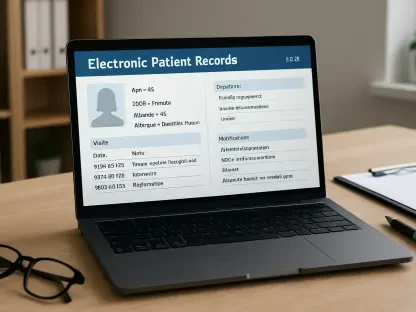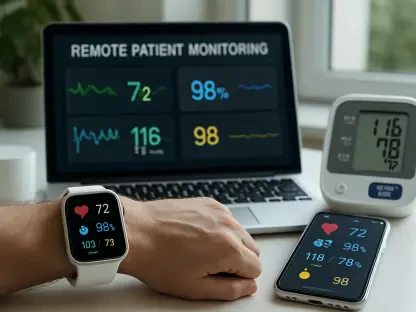Imagine a small-town resident with a chronic illness, relying on a nearby hospital for life-saving care, only to find the doors shuttered due to financial collapse or a devastating cyberattack, a scenario that is becoming alarmingly common across the United States. As rural hospitals face unprecedented challenges, patients are left stranded without local access to treatment, and the ripple effect compromises the security of sensitive medical data while they navigate unfamiliar systems. The intersection of disrupted care and heightened cyber risks paints a troubling picture for communities already struggling with limited resources. As nearly 700 rural hospitals teeter on the brink of closure, the urgency to address both patient well-being and data protection has never been greater. This pressing issue demands attention to understand the full scope of consequences and explore actionable solutions for safeguarding vulnerable populations.
1. Unveiling the Crisis in Rural Healthcare
The plight of rural healthcare is exemplified through countless stories of patients caught in the fallout of hospital closures. Consider a fictional patient with a chronic respiratory condition, whose local hospital was a lifeline during health crises. When that facility closed due to financial strain and staffing shortages, the nearest alternative was nearly an hour away. Delays in treatment, repeated diagnostic tests, and missing medical records became the new norm, significantly increasing health risks. Subsequent closures, including one triggered by a ransomware attack, forced this patient to shuttle between distant clinics, manually carrying test results. Even when a hospital reopened nearby under new ownership, critical medical history failed to transfer, amplifying both health and data security concerns. Such experiences highlight the profound personal toll of losing local healthcare access, where every closure chips away at the foundation of consistent, reliable medical support.
Beyond individual struggles, the broader reality is equally stark, with real-world events underscoring the severity of this crisis. In a notable instance from a few years back, two rural hospitals in Illinois shut down after a ransomware attack crippled operations for over 14 weeks. Although one eventually reopened under new management, the transition sparked fresh worries about the security of electronic protected health information (ePHI). Across the nation, hundreds of rural facilities face similar risks of closure, threatening to disrupt care continuity for entire communities. The cascading effects include delayed treatments and fragmented medical histories, while each transition to a new provider or system introduces potential cyber vulnerabilities. These incidents are not isolated; they reflect a systemic issue that jeopardizes both patient outcomes and the integrity of sensitive health data on a national scale.
2. Examining the Dual Impact on Care and Data
When rural hospitals close, the immediate consequence is a severe disruption in patient care that affects entire communities. Access to local medical services vanishes, forcing patients to travel long distances for even basic treatment. This often results in critical delays, especially during emergencies, where every minute counts. Additionally, the loss of a familiar care setting means medical histories become fragmented as patients are thrust into unfamiliar systems. Without seamless access to prior records, healthcare providers must start from scratch, repeating tests and risking errors in diagnosis or treatment plans. This fragmentation not only undermines health outcomes but also erodes trust in the healthcare system, leaving vulnerable populations in rural areas particularly exposed to worsening conditions due to the absence of timely, informed care.
Equally concerning is the heightened risk to data security that accompanies these closures. Each transition to a new provider or system creates additional access points for sensitive ePHI, making it a prime target for cybercriminals. Poorly managed handoffs can lead to a loss of visibility over where data resides and who can access it, opening the door to breaches or unauthorized use. Cyber threats, such as ransomware, have already proven their ability to shutter hospitals temporarily or permanently, exacerbating the problem. As patient information moves across unsecured channels or outdated systems during these transitions, the likelihood of exposure increases significantly. Protecting this data is not just a compliance issue; it is a fundamental component of maintaining patient safety and trust in an already strained rural healthcare landscape.
3. Practical Steps for Safeguarding Patient Care and Data
Rural hospitals, despite operating with constrained budgets and staff, can take actionable steps to protect both patient care and data integrity. A critical starting point is conducting a HIPAA-compliant, asset-based risk analysis to identify where ePHI is stored, who accesses it, and what vulnerabilities exist. This assessment aligns with the Security Rule and meets expectations set by the Office for Civil Rights (OCR), providing a prioritized roadmap to secure sensitive information. Without such an evaluation, facilities remain blind to threats that could disrupt operations or compromise patient safety. Implementing this measure ensures that limited resources are directed toward the most pressing risks, fortifying the foundation of care delivery and data protection in environments where every decision must count.
Another essential strategy involves adopting the Health Industry Cybersecurity Practices (HICP) framework under 405(d), designed specifically for resource-limited hospitals. This framework offers practical safeguards to assess current security maturity and address gaps that could impact patient care. By prioritizing key controls, small hospitals can maintain secure, uninterrupted operations even under strain. Failing to establish this baseline risks overlooking critical protections that ensure system stability and care continuity. Additionally, basic cyber hygiene practices—such as installing endpoint protection, filtering email for phishing and malware, and securing remote access for staff and vendors—are non-negotiable. Neglecting these fundamentals leaves systems vulnerable, directly threatening patient safety and data security in settings already at risk of disruption.
4. Strengthening Oversight and Long-Term Planning
A further critical step for rural hospitals is to evaluate vendor access and data-sharing protocols as reliance on external partners grows. With ePHI often following service shifts, confirming that business associate agreements comply with HIPAA and that vendors maintain robust security practices is vital to minimizing risks. Mapping sensitive data flows helps prevent unmonitored transfers or unintended exposures, while avoiding insecure methods like email, fax, or USB drives reduces unnecessary vulnerabilities. Continuous threat monitoring also plays a pivotal role, enabling hospitals to detect and respond to issues before they disrupt systems or expose data. Leveraging managed services can fill gaps when in-house resources are limited, ensuring real-time visibility and swift action on alerts to meet HIPAA requirements and keep care uninterrupted.
Building resilience requires more than technical measures; it demands active leadership engagement across all levels. Cybersecurity must be treated as a hospital-wide priority, embedded into governance and decision-making. Involving board members, executives, and clinical leaders in risk discussions, and communicating threats in clear terms linked to patient safety and financial stability, fosters a unified approach. Leadership support inspires staff to prioritize security, closing gaps that attackers exploit. Finally, developing a phased, realistic improvement plan ensures steady progress by focusing on high-impact actions aligned with available funding and capacity. A multi-year strategy based on risk analysis, targeting critical vulnerabilities first, maximizes impact without overstretching resources. Skipping this planning leaves hospitals exposed to persistent threats.
5. Navigating Data Risks During Care Transitions
Hospital closures, whether permanent or temporary due to events like ransomware recovery, often force patient data to move across new systems and providers, amplifying cyber risks. Shifting services to external vendors or referring patients to distant clinics can create unsecured access points for ePHI if transitions are not meticulously managed. The loss of visibility over data during these handoffs provides fertile ground for attackers seeking to exploit weaknesses. This challenge is compounded when hospitals lack standardized protocols for secure data sharing, leaving sensitive information vulnerable to breaches or misuse. Addressing these risks is essential to prevent disruptions in care and maintain compliance with regulatory standards, ensuring that patient trust is not further eroded during already turbulent times.
To mitigate these dangers, rural hospitals must prioritize structured solutions for secure transitions. Starting with a HIPAA-compliant risk analysis helps uncover where data resides, who accesses it, and what vulnerabilities could compromise care. Emphasizing basic security measures, training staff on best practices, and engaging leadership in oversight are crucial steps. Developing a phased plan tailored to safeguard patients and their data through disruptions provides a clear path forward. Poor planning during closures heightens risks to care quality and regulatory adherence, undermining confidence in the healthcare system. By proactively addressing these challenges, hospitals can better protect ePHI and maintain continuity of care, even under the pressure of potential shutdowns or operational shifts.
6. Reflecting on Solutions for a Safer Future
Looking back, the wave of rural hospital closures revealed deep vulnerabilities in both patient care delivery and data security, as communities grappled with the loss of local access and the fallout of fragmented medical systems. The real-world impact of ransomware attacks and financial instability forced many facilities to shut their doors, leaving patients to navigate long distances and unfamiliar providers. These events underscored the urgent need for robust cybersecurity measures and strategic planning to protect electronic protected health information during turbulent transitions. The lessons learned from past disruptions highlighted that without proactive intervention, the risks to health outcomes and data integrity would only continue to grow.
Moving forward, actionable steps emerged as a beacon of hope for struggling rural hospitals. Implementing HIPAA-compliant risk analyses, adopting tailored frameworks like HICP, and prioritizing basic cyber hygiene proved essential in safeguarding critical systems. Engaging leadership and crafting phased improvement plans ensured that limited resources were used effectively to address the most pressing threats. As the healthcare landscape continues to evolve, rural facilities must commit to ongoing threat monitoring and secure data-sharing practices with vendors. These efforts, grounded in past challenges, pave the way for stronger resilience, ensuring that patient care and sensitive information remain protected against future uncertainties.









